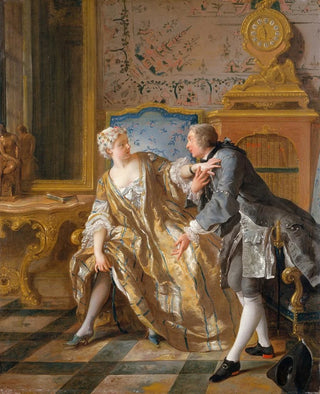Art print | La Jarretière - Jean-François de Troy


View from behind

Frame (optional)
La Jarretière, an iconic art print by Jean-François de Troy, is set in a period where refinement and elegance were at the heart of artistic concerns. This canvas, which evokes both sensuality and delicacy, transports the viewer into a universe where beauty is omnipresent. The scene, both intimate and laden with meaning, invites deep contemplation, revealing the subtleties of human relationships and the social conventions of the time. Through this work, de Troy manages to capture a fleeting moment, a suspended instant where time seems to stand still, allowing the viewer to immerse themselves in the delicate atmosphere of 18th-century French court.
Style and uniqueness of the work
Jean-François de Troy's style is distinguished by its refined approach and mastery of colors. In La Jarretière, soft and luminous hues blend harmoniously, creating a warm and welcoming atmosphere. The composition is carefully orchestrated, with each element arranged with precision that reflects the artist's talent. The figures, delicately rendered, seem almost alive, their expressions and postures revealing psychological depth. This painting perfectly illustrates the art of female representation, where grace and beauty are sublimated through meticulous attention to detail. The art print itself, a symbol of fashion and seduction, becomes a central element of the visual narrative, reinforcing the idea of feminine elegance.
The artist and his influence
Jean-François de Troy, a prominent figure of the 18th century, established himself as a renowned painter thanks to his skill in capturing the customs of his time. Trained in the workshop of great masters, he developed a style that combines tradition and innovation. His work is not limited to simple representation but engages the viewer in a reflection on society and human relationships. De Troy also influenced many artists of his era, who saw in him a role model to follow. His narrative approach and attention to detail have left a lasting mark in the history of art, making him a pioneer in the field of painting.

Matte finish

View from behind

Frame (optional)
La Jarretière, an iconic art print by Jean-François de Troy, is set in a period where refinement and elegance were at the heart of artistic concerns. This canvas, which evokes both sensuality and delicacy, transports the viewer into a universe where beauty is omnipresent. The scene, both intimate and laden with meaning, invites deep contemplation, revealing the subtleties of human relationships and the social conventions of the time. Through this work, de Troy manages to capture a fleeting moment, a suspended instant where time seems to stand still, allowing the viewer to immerse themselves in the delicate atmosphere of 18th-century French court.
Style and uniqueness of the work
Jean-François de Troy's style is distinguished by its refined approach and mastery of colors. In La Jarretière, soft and luminous hues blend harmoniously, creating a warm and welcoming atmosphere. The composition is carefully orchestrated, with each element arranged with precision that reflects the artist's talent. The figures, delicately rendered, seem almost alive, their expressions and postures revealing psychological depth. This painting perfectly illustrates the art of female representation, where grace and beauty are sublimated through meticulous attention to detail. The art print itself, a symbol of fashion and seduction, becomes a central element of the visual narrative, reinforcing the idea of feminine elegance.
The artist and his influence
Jean-François de Troy, a prominent figure of the 18th century, established himself as a renowned painter thanks to his skill in capturing the customs of his time. Trained in the workshop of great masters, he developed a style that combines tradition and innovation. His work is not limited to simple representation but engages the viewer in a reflection on society and human relationships. De Troy also influenced many artists of his era, who saw in him a role model to follow. His narrative approach and attention to detail have left a lasting mark in the history of art, making him a pioneer in the field of painting.






